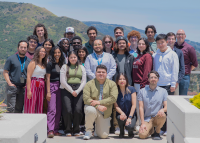CBS Los Angeles (KCAL News) Features HRL Laboratories in Look At This! Segment
CBS Los Angeles (KCAL News) recently profiled HRL Laboratories and gave a peak into our rich history. HRL continues the legacy of technology advances that began as Hughes Research Laboratories, established by Howard Hughes in 1948. From the first laser in 1960 to today’s innovations that will shape the future, we are striving to anticipate, …
Continue reading “CBS Los Angeles (KCAL News) Features HRL Laboratories in Look At This! Segment”
HRL Project Will Keep Data Cool with Far Less Energy

New Award Under ARPA-E COOLERCHIPS Program Aimed at Extremely Efficient Thermal Management for Next-Generation Data Centers to Reduce Carbon Emissions, Mitigate Climate Change
HRL Hosts Open Quantum Initiative Fellowship Students

On June 12, 2023, HRL Laboratories held a one-day launch visit for the Open Quantum Initiative (OQI) Undergraduate Fellowship program. Organized by the Chicago Quantum Exchange, OQI offers undergraduates from diverse communities an opportunity to experience life in a working quantum science laboratory or research group.
HRL Laboratories to Share Silicon Qubit Technology

HRL Laboratories, LLC is partnering with the Laboratory for Physical Sciences’ Qubit Collaboratory to fabricate cutting-edge silicon quantum dot devices for distribution to academic and government researchers. The effort aims to improve access to next-generation quantum dot technology to accelerate discovery in quantum science.
HRL Laboratories’ 3D-Printable Aluminum Authorized for Use in World’s Fastest Race Cars

HRL Laboratories, LLC, achieved another milestone for its 7A77 aluminum alloy and feedstock powder designed specifically for additive manufacturing when the material was officially authorized for parts on Formula One race cars.
HRL Laboratories Aims at Unprecedented High-Frequency Performance in Gallium Nitride MMICs Based on Traditional Silicon Semiconductor Fabrication Techniques

HRL Laboratories, LLC, is developing Efficient GaN Integrated G-band Monolithic Arrays (ENIGMA), a project funded by DARPA. ENIGMA will address a gap in technology between the compound semiconductor monolithic microwave integrated circuit industry and the silicon radio-frequency integrated circuit industry.
HRL to Make SENSE of Analyst Neuro-Ergonomics

HRL Laboratories, LLC, has been selected by the National Geospatial-Intelligence Agency to proceed with Sensemaking Effectiveness using Neurocognitive Signatures of Efficiency (SENSE), a system capable of assessing efficacy of new AI-enabled assistance tools by measuring neurophysiological indicators in the GEOINT analysts using them. Such assessments will help engineers find a proper balance between analyst fatigue and analysis improvement offered by human-machine teaming.
HRL Laboratories Silicon Encoded Spin Qubits Achieve Universality

HRL Laboratories, LLC, has published the first demonstration of universal control of encoded spin qubits. This newly emerging approach to quantum computation uses a novel silicon-based qubit device architecture, fabricated in HRL’s Malibu cleanroom, to trap single electrons in quantum dots. The article Universal logic with encoded spin qubits in silicon was posted online ahead of publication in the journal Nature. HRL is a world leader in silicon qubit technology.
Built In Honors HRL Laboratories in Its Esteemed 2023 Best Places to Work Awards

Built In announced that HRL Laboratories, LLC was honored in its 2023 Best Places To Work Awards. Specifically, HRL earned a place on Best Midsize Companies (101-1000 employees), Los Angeles, CA. The annual awards program includes companies of all sizes, from startups to those in the enterprise, and honors both remote-first employers as well as companies in large tech markets across the U.S.
Dr. Minh Nguyen of HRL Laboratories Named SPIE Fellow

HRL Laboratories Senior Research Engineer Binh-Minh (Minh) Nguyen, PhD, has been elected a Fellow of the International Society for Optics and Photonics (SPIE) for 2023.